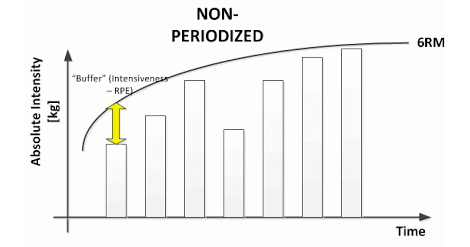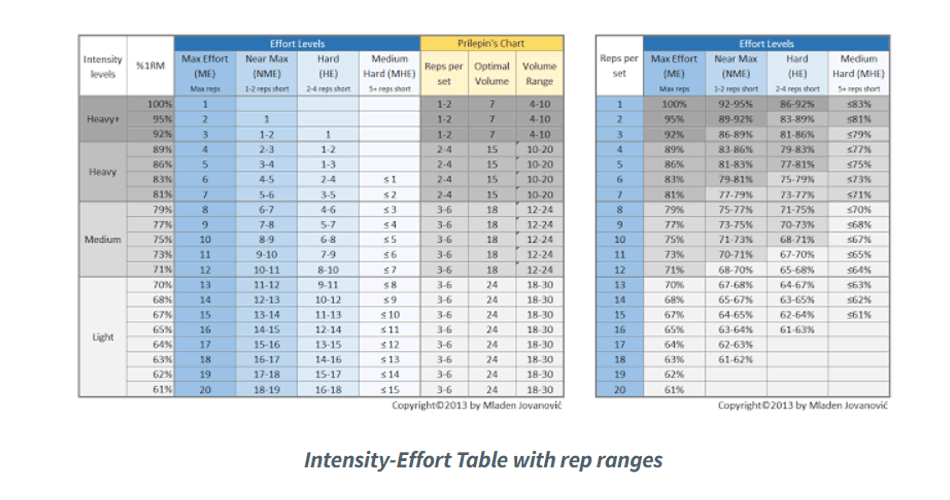Planning the Strength Training (Part 2)
In case you missed the previous part of this excellent article series you can find them here: Part 1
VOLUME-INTENSITY TRADE-OFF MYTH
As we have outlined, volume and intensity are un-splittable and principal parts of the load. There is one myth that exists and its called volume-intensity trade off. Yes, there is a trade-off, but it depends on time-frame under which you analyze the load. Under most shortest time-frame, there is trade-off between volume and intensity: the more weight on the bar, the less reps you could do with it. Yet again, you can do 8 reps with 10RM and you can do 9 reps with the same load, so this volume-intensity trade off exists only on weight-repetition maximum (RM) relation, and there is no reason to use it on larger time-frame scales of loading (exercise load, workout load, microcycle load, etc). You could also do 3 sets of 3 reps with 3RM, or you could do 1 or 5 sets (depending on the work capacity, level and the purpose of workout) either. Managing volume and intensity is very important aspect of training and loading, especially with intermediate and advanced athletes and falling under to volume-intensity trade-off dogma limits you for numerous solutions.
Intensity and volume are NOT reversely related. All volume/intensity combos serve their purpose in training and here are couple of examples.
| Volume | Intensity | Purpose |
|---|---|---|
| Medium | Medium | Bread and butter of training |
| High | High | Push one into mild overtraining (overreaching) and lead to greater gains once followed by a taper |
| Low | Low | Active recovery / deload |
| Low | High | Sets PRs |
| High | Low | Build foundation for stable gains |
Modified from Tsatsouline, Pavel (2005). Beyond Bodybuilding. Dragon Door Publications.
It is true that one of the characteristic of advanced lifters is that their training must be organized into longer periods of time, and those periods progress from higher volume and lower intensity toward lower volume and higher intensity. That is basically a trade-off if you look at it that way, but there are also other solutions to train advanced athletes. It is important to unlock volume and intensity.
It is interesting to note that linear periodization or Western periodization is actually a misunderstand Third Zoom Level (load progression) of advanced Olympic lifters. Those guys spend some time at emphasizing volume of training and technique at doing great number of sets at lower-medium percentage of their PBs in clean/jerk and snatch (i.e. 8-10 sets of 2-3 reps at 70-80% or something like that) and then transitioning to intensity phase utilizing smaller number of sets with greater intensity (i.e. 4-6sets of 1-2 reps with 80-90%). This way they approach planning the load for development of strength-speed necessary of Olympic lifts (linear periodization). How do they integrated development of strength-speed with other components like relative strength, muscle mass and reactive strength is a matter of Second Zoom Level.
But some wise guy(s) from Western hemisphere used this linear progression of the load (where lifters utilized great number of sets with 1-3 reps at lower intensity) that was used to develop strength-speed for Olympic lifts and applied it to Second Zoom Level by utilizing 10-15 reps per set in volume phases and 1-3 reps per set in intensity phases and named it Western periodization (or others did this for them). This way they passed through whole repetition continuum and stressed most of strength qualities in serial manner. And then confusion started with the idea that you must spend some time with 10-12 reps to improve your 1RM. That’s OK with the novices, kids etc, but this was actually suggested to advanced lifters. Yes, there is time and place for this too, but the issue I am trying to emphasize here is that you cannot analyze one system using only one Zoom Level, you must understand all three of them.
And after those wise Western guy(s) defined western periodization (which was actually misunderstood load progression of Olympic lifters – linear periodization), Westside guys (WSBB) critiqued its serial development of abilities and devised conjugate training (actually complex-parallel approach), as something new (which is certainly not, since complex-parallel approach is the traditional/first one). Lately, Westside guys also utilized Accumulation/Intensification phases (or Volume-Intensity phases) in their load progressions for a given strength ability (usually maximum strength and ME method) and also started to emphasize given quality over a certain period of time and then the things started to go in circle again.
People were/are confused. They don’t know what linear periodization means, what is traditional, what is concurrent, what is western, what is block, what is conjugated. I am not saying I know, but things start to finally open. This is because they don’t see the big picture and don’t have Three Zoom Levels. It all started with the fact that advanced athletes need more volume-intensity alternations (volume phase, intensity phase) as a method of load progression (Third Zoom Level) to further develop certain motor ability. Then some wise guy(s) applied this principle to whole repetition continuum which affected Second Zoom Level and appeared that all motor abilities are developed sequentially/serially. And this is the root of this problem.
So, the solution is to look at the problem from Three Zoom Levels. There is (1) planning of the season, there is the (2) approach to develop multiple motor abilities (complex-parallel, block, emphasis) depending on the level of the athletes and there is (3) planning of the loading for a given abilities again depending on the development, organization and level of the athlete. Do not mix those three levels of planning and there will be no confusion.
TRAINING FREQUENCY AND WORK CAPACITY
Managing training intensity, volume and frequency are key for optimal loading and training adaptation, avoidance of setback and overtraining. Training frequency is a term that is also hard to define like intensity and volume. Some authors consider training frequency as a number of training session in a microcycle, some of them define it as number of training sessions per muscle group per microcycle, or as number of training sessions per training goal.
Basically, you need to take into consideration both definitions, since you need to take into account muscle loading, central nervous system loading, endocrine system loading and the joints loading (maybe some more, but can’t remember now)
Training frequency depends on a lot of factors, like training goal, training phase, level of the athlete and work capacity. Numerous training systems are different variations of intensity, volume and frequency combos.
Work capacity is also hard to define and usually, it is context-dependent and has also a huge number of subtypes. Basically, work capacity is the ability to sustain training load and recover from it efficiently. You cannot develop work capacity by doing a bunch of sled work and intervals. This will develop a form of aerobic power that could be used to speed up recovery between sets, but this also depends on sets type (what repetition continuum zone). Work capacity is usually something that must be looked at larger time-frame (like microcycle), and it is something that develops over the years. Basically, you can manage to survive a given training session, but you may not actually recover from it in matter of days even weeks due poor work capacity. Factors that affect training frequency also affect work capacity, like muscle loading and ability to recover from it, central nervous system loading and toleration for such a work, endocrine system loading and ability to recover from it and joint loading and ability to sustain it.
Thus, the optimal training frequency depends on the goals of training, intensity and volume of training and fatigue type they develop (muscular, CNS, endocrine, joint…), level of the athlete and work capacity.
| Type of loading/fatigue | Description |
|
Muscle loading/fatigue Local effect |
Volume of eccentric loading and work done. Proximity of failure (greater eccentric stress). Note that micro-trauma and total protein break-down in a workout can affect CNS via inflammatory cytokines. |
|
CNS loading/fatigue Central effect |
Volume of compound movements (great muscle mass and total MU recruitment), volume of work in >90% 1RM, proximity of failure (intensiveness, RPE of sets, psychological effort), speed of contraction, amount of micro-trauma and total protein break-down (volume of eccentric contractions) via inflammatory cytokines |
|
Endocrine loading/fatigue Central effect |
Total volume of training |
|
Joints loading/fatigue Local effect |
Total volume of training above certain threshold. Note that micro-trauma in a workout can affect CNS via inflammatory cytokines |
One thing that I realized when working with soccer players (not directly related to strength training, but it is highly related to this work capacity issue), is that it is very easy to prepare them for one match. Most of them can play on ’freshness’ as they use to call it. But, after that match, they will need more recovery days, and this will limit them in the long run due lowered technical and tactical skill work. Having poor work capacity will cause training and competition inconsistency, or performance swings, usually with periods of setback and injuries in between. Thus, one of the goals is to prepare them not just for one match, but for the whole week loading and number of serial matches. Improved work capacity will improve training and performance consistency and allow them to have longer peak or play a whole very long season with great performance and not swinging from match to match. Athletes with great work capacity (again, not just aerobic power but the ability to sustain long term loading and recover from it) are always on the scene, and guys will lower work capacity will be at peak every now and then, and most of the time injured. So, I guess the key to performance consistency and sports success is high work capacity.
There is also an upper-end of work capacity which is actually a whole point behind the block and emphasis approach of training. As you become advanced, you just simply cannot pound on everything at once and manage to recover from it, without setbacks, limited progress and overtraining. You focus your efforts on a couple of things, make them move again and then switch. Rinse and repeat. That is the whole point behind the block and emphasis approach and the main limitation of the traditional complex-parallel approach.
But don’t think that improving work capacity is not possible. Let me cite Mike Tuchscherer from his The Reactive Training Manual, page 47:
It is important to note that if you don’t elevate your work capacity, then you are setting up for early stagnation due to an inability to accomplish and recover from work. Basically, as you become more advanced and it takes more work to make gains, you won’t be able to do more work because if you do, you will overtrain. This isn’t something few weeks of sled dragging is going to fix. Work capacity is developed over the years of training, which is why it is vitally important not to forget about it in your current stage of training.
This brings me to the fact that some athletes are not that advanced that they need more advanced planning, they just suck at their work capacity, and maybe one solution to the problem is to develop their work capacity before going to more advanced stages, where the lack of it may limit their real potential.
One approach to this problem is to play with intensity, volume and frequency combos. Mike Tuchscherer suggests using two different combos from time to time in every training phase.
| Combo Name | Purpose | Organization |
| Fatigue-Based | To teach your body how to recover from large amount of fatigue | The frequency is lower, but the fatigue induced by each session is high. |
| Frequency-Based | To teach your body to recovery from smaller bouts of fatigue more quickly | The frequency is higher, but the fatigue induced by each session is lower |
Modified from Tuchscherer, Michael (2008). The Reactive training manual.
Please note that the term fatigue refers to total stress (load) induced by a workout. It is not simply volume and not simply intensity, it’s their interaction.
By rotating both into your training, your work capacity goes up, therefore your ability to accomplish and recover from training goes up too. Emphasizing one combo and then rotating may be done on every level of training and with any goal too.
To conclude: to improve training adaptation, avoid setback and overtraining via improvements in work capacity, it is necessary to manage intensity, volume and frequency combos of the training load. Case closed!
MICROCYCLES AND THEIR CLASSIFICATION
Microcycle is the shortest training cycle. It encompasses a number of workouts and lasts a number of days, most often one week. There are six types of training microcycles, characterized by a specific purpose, load levels, particulars of workload design and duration. There is a differentiation between microcycles in three principal ways: loading, competing and recovery.













Responses